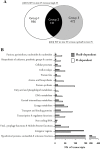PhoB activates Escherichia coli O157:H7 virulence factors in response to inorganic phosphate limitation
- PMID: 24710330
- PMCID: PMC3978041
- DOI: 10.1371/journal.pone.0094285
PhoB activates Escherichia coli O157:H7 virulence factors in response to inorganic phosphate limitation
Abstract
Enterohemorrhagic Escherichia coli (EHEC), an emerging food- and water-borne hazard, is highly pathogenic to humans. In the environment, EHEC must survive phosphate (Pi) limitation. The response to such Pi starvation is an induction of the Pho regulon including the Pst system that senses Pi variation. The interplay between the virulence of EHEC, Pho-Pst system and environmental Pi remains unknown. To understand the effects of Pi deprivation on the molecular mechanisms involved in EHEC survival and virulence under Pho regulon control, we undertook transcriptome profiling of the EDL933 wild-type strain grown under high Pi and low Pi conditions and its isogenic ΔphoB mutant grown in low Pi conditions. The differentially expressed genes included 1067 Pi-dependent genes and 603 PhoB-dependent genes. Of these 131 genes were both Pi and PhoB-dependent. Differentially expressed genes that were selected included those involved in Pi homeostasis, cellular metabolism, acid stress, oxidative stress and RpoS-dependent stress responses. Differentially expressed virulence systems included the locus of enterocyte effacement (LEE) encoding the type-3 secretion system (T3SS) and its effectors, as well as BP-933W prophage encoded Shiga toxin 2 genes. Moreover, PhoB directly regulated LEE and stx2 gene expression through binding to specific Pho boxes. However, in Pi-rich medium, constitutive activation of the Pho regulon decreased LEE gene expression and reduced adherence to HeLa cells. Together, these findings reveal that EHEC has evolved a sophisticated response to Pi limitation involving multiple biochemical strategies that contribute to its ability to respond to variations in environmental Pi and to coordinating the virulence response.
Conflict of interest statement
Figures






Similar articles
-
Regulation of waaH by PhoB during Pi Starvation Promotes Biofilm Formation by Escherichia coli O157:H7.J Bacteriol. 2019 Aug 22;201(18):e00093-19. doi: 10.1128/JB.00093-19. Print 2019 Sep 15. J Bacteriol. 2019. PMID: 31262835 Free PMC article.
-
Hfq virulence regulation in enterohemorrhagic Escherichia coli O157:H7 strain 86-24.J Bacteriol. 2011 Dec;193(24):6843-51. doi: 10.1128/JB.06141-11. Epub 2011 Oct 7. J Bacteriol. 2011. PMID: 21984790 Free PMC article.
-
Identification and characterization of novel phosphate regulon genes, ecs0540-ecs0544, in Escherichia coli O157:H7.Mol Genet Genomics. 2010 Sep;284(3):197-205. doi: 10.1007/s00438-010-0559-y. Epub 2010 Jul 17. Mol Genet Genomics. 2010. PMID: 20640580
-
Interplay between genetic regulation of phosphate homeostasis and bacterial virulence.Virulence. 2014;5(8):786-93. doi: 10.4161/viru.29307. Epub 2014 Oct 31. Virulence. 2014. PMID: 25483775 Free PMC article. Review.
-
The Locus of Enterocyte Effacement and Associated Virulence Factors of Enterohemorrhagic Escherichia coli.Microbiol Spectr. 2014 Aug;2(4):EHEC-0007-2013. doi: 10.1128/microbiolspec.EHEC-0007-2013. Microbiol Spectr. 2014. PMID: 26104209 Review.
Cited by
-
Staphylococcus aureus Preferentially Liberates Inorganic Phosphate from Organophosphates in Environments where This Nutrient Is Limiting.J Bacteriol. 2020 Oct 22;202(22):e00264-20. doi: 10.1128/JB.00264-20. Print 2020 Oct 22. J Bacteriol. 2020. PMID: 32868400 Free PMC article.
-
Activation of the PhoPR-Mediated Response to Phosphate Limitation Is Regulated by Wall Teichoic Acid Metabolism in Bacillus subtilis.Front Microbiol. 2018 Nov 6;9:2678. doi: 10.3389/fmicb.2018.02678. eCollection 2018. Front Microbiol. 2018. PMID: 30459743 Free PMC article. Review.
-
Regulatory roles of an sRNA derived from the 5´ UTR and sequence internal to lapA in Pseudomonas aeruginosa PAO1.Microbiol Spectr. 2025 Jun 3;13(6):e0130324. doi: 10.1128/spectrum.01303-24. Epub 2025 Apr 22. Microbiol Spectr. 2025. PMID: 40261038 Free PMC article.
-
Xenobiotic Effects of Chlorine Dioxide to Escherichia coli O157:H7 on Non-host Tomato Environment Revealed by Transcriptional Network Modeling: Implications to Adaptation and Selection.Front Microbiol. 2020 Jun 3;11:1122. doi: 10.3389/fmicb.2020.01122. eCollection 2020. Front Microbiol. 2020. PMID: 32582084 Free PMC article.
-
Genome-Wide Screening for Novel Candidate Virulence Related Response Regulator Genes in Xanthomonas oryzae pv. oryzicola.Front Microbiol. 2018 Aug 7;9:1789. doi: 10.3389/fmicb.2018.01789. eCollection 2018. Front Microbiol. 2018. PMID: 30131784 Free PMC article.
References
-
- Parkinson JS (1993) Signal transduction schemes of bacteria. Cell 73: 857–871. - PubMed
-
- Oshima T, Aiba H, Masuda Y, Kanaya S, Sugiura M, et al. (2002) Transcriptome analysis of all two-component regulatory system mutants of Escherichia coli K-12. Mol Microbiol 46: 281–291. - PubMed
-
- Wanner BL (1996) Phosphorus assimilation and control of the phosphate regulon. In: F. C. Neidhardt RCI, J. L Ingraham, E. C. C Lin, K. B Low, B Magasanik, W. S Reznikoff, M Riley, M Schaechter, and H. E Umbarger. Escherichia coli and Salmonella: Cellular and Molecular Biology. 2 ed. ASM Press, Washington, D.C. pp. 1357–1381.
-
- Rao NN, Torriani A (1990) Molecular aspects of phosphate transport in Escherichia coli . Mol Microbiol 4: 1083–1090. - PubMed
Publication types
MeSH terms
Substances
LinkOut - more resources
Full Text Sources
Other Literature Sources
Molecular Biology Databases
Research Materials
Miscellaneous

